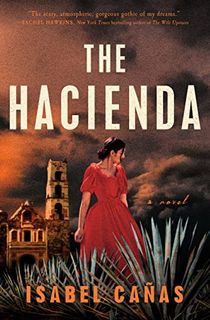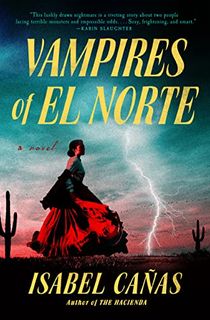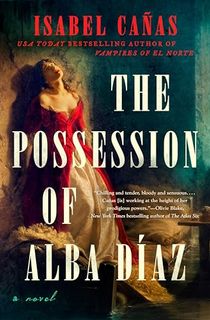Isabel Cañas really wants to set a novel in early California within the next five years. She grew up in Orange County for nine years during her teen years before becoming a Bram Stoker-nominated historical horror and romance writer and author of The Hacienda, Vampires of El Norte, and, most recently, The Possession of Alba Diaz.
“I've never met anybody more deeply xenophobic and racist against Mexicans than Californians,” notes Cañas. “And I'm like, ‘but where do you live? San Diego, Santa Monica? Look at the names. Oh yeah. Yep.’ The Spaniards came here and fucked things up for the Indigenous people. But there is a legacy here that you refuse to engage with. And so I hope that my novels challenge that.”
Like her novels, Cañas’ short fiction also challenges our preconceived notions of history through an Anglo-Saxon lens. Her shorts have been anthologized in The Best American Science Fiction & Fantasy and The Year’s Best Dark Fantasy & Horror, and Díaz has lived in México, Scotland, Egypt, Turkey, and New York City, among other places.
The author now lives in the Pacific Northwest and holds a doctorate in Near Eastern Languages and Civilizations and writes yearning horromance fiction inspired by her research and Mexican-American heritage.

“No Other Life” in Nightmare Magazine #82 (2019)
“Cities like her make men leave their hearts on their shores” is the apt beginning of Isabel Cañas’ “No Other Life” from Nightmare Magazine #82.
It’s a story that shows her historian’s curiosity through a speculative fiction lens. Cañas rarely receives interview questions about her older short stories, which often read like miniaturized versions of her character-rich novels.
“Thank you so much for asking me about this story, because no one ever has, it's a deep cut, and I adore this piece,” Cañas enthuses about “No Other Life.”
“It’s a love letter to the city of Istanbul. I spent the best summers of my life living in Istanbul studying Turkish. My PhD is in Ottoman studies, and I'm a Medievalist by training. I spent many wonderful summers in Turkey studying modern Turkish and Ottoman Turkish,” Cañas remembers.
When it came time to write a story in the middle of her PhD, Cañas brought Istanbul to the Clarion West Writers Workshop in 2018; she knew her setting right away.
“So I was both learning and teaching so much about the Ottoman Empire, and it was a place that just felt so alive, and the city of Istanbul is one of those cities that feels like a whole world unto itself. It's a metropolis like New York City or London that has just layers and layers of history.”
Cañas would often walk from her tiny apartment near the university and go to a fountain that had “casually” been there since the 1700s and that wasn’t even that old in comparison to other Istanbul historical sites.
“I'd go and take friends to the Byzantine Cisterns in the tourist district, and it was just a really magical place to live where it felt like the boundaries between the present and the past were so blurred, and there were so many layers of time that I was interested in in this particular place,” said Cañas.
The horror author knew that Istanbul’s rich history was something that had inspired so much wonder and that, in turn, pushed her to write a tale about vampires. She followed the romanticism and lyricism of the historic Turkish city and focused on the “yearning” of her characters.
She laughs, “I was a Twilight girlie at 17 and fell for the big bad when I first read Dracula at age 17.”
Cañas was talking to her husband about her career recently and what books and genres she wants to try out in the future. She was concerned whether her readers would follow her if she tried something new.
“This is a fear that one can have in publishing. When you stumble into good fortune, you're afraid to let it go.”
Short stories allow her to experiment with genre, voice, and setting in a lower-stakes environment, which she loves about this particular form of writing.

The Hacienda
The main character in Isabel Cañas’ gothic debut novel, The Hacienda, is Beatriz, 20, the new bride of a rich Mexican landowner named Don Rodolfo.
This emotionally rich blend of horror, romance, suspense, and supernatural gothic came after years of rejections in the fantasy space. The log line gets it right on the head: “Mexican Gothic meets Rebecca.”
The Hacienda is set in 1823, shortly after the bloody Mexican War of Independence, and Beatriz’s family had the misfortune of being on the wrong side. Her father is dead, and her mother is penniless, so it’s clear marriage is the only way to climb her way up. And on top of all that, Beatriz’s new home is haunted…
Beatriz sets the novel in México, but California Catholic churches and missions inspired her a lot. “I was 10 years old when we moved to Orange County, and my teen years were within spitting distance of the mission, San Juan Capistrano,” said Cañas.
“We went to that church every Sunday. There are scenes in The Hacienda where they're in a chapel, and that was inspired by the chapel at the mission. Every church, basically, in my books, was harkening back to that particular one. I have no desire to be Catholic. I grapple with lots of Catholicism in my books because that is how I was raised, and it's just in my DNA, whether I like it or not. But you can't argue with the fact that Catholic churches are…they're old Catholic churches. None of this new evangelical wannabe bullshit. But old Catholic churches have a drama and a gothic aesthetic that even when I was staring up at painted ceilings, I was like, ‘oh, this shit slaps. This is cool.’”
“I wrote a novel that got me my agent in 2017, " said Cañas.” “It was a young adult fantasy novel, and at the time, YA fantasy was a very tough market to get into. It was very competitive, and I was good, but apparently not good enough, which is fine, neither here nor there.”
Cañas finally got her rejection notice for that novel while she was on honeymoon in México City with her husband, and she just broke down sobbing in public, and her husband gave her the “let's get back in the saddle” pep talk and spurred her to try that haunted house story she had put on the shelf.
She wrote a book about being trapped in a house while she was trapped in her Brooklyn apartment during the COVID-19 pandemic. Overall, Cañas loves how the book turned out after a rollercoaster of ups and downs with her agent. She took extra time to hone her craft with more workshops and individual tutoring sessions.
“I really believe that the more you work with intention and care and curiosity and vulnerability about your own shortcomings, the better the outcome.”

“All The Things I Know About Ghosts, By Ofelia, Age 10” in The Deadlands Magazine (2023)
“I don't think it's a perfect story, but it has a lot of really raw personal elements,” Cañas notes about her 2023 short story “All the Things I Know About Ghosts, By Ofelia, Age 10.”
“My mother's brother passed away at two or three years old from unknown causes. He was very sick. My grandmother's brother drowned when he was 16 in a freak accident. So those elements are a part of the story, and it was really difficult to write,” noted Cañas.
She recounts a story of a flooded town from her family’s history and how honored she is to be the storyteller for her family now. The town was in the Padilla Municipality, which was a town in the Mexican state of Tamaulipas.
After the flood at the Vicente Guerrero Dam in 1970, the seat was moved from Padilla to the town of Nuevo Padilla. Padilla is known for being the place where the Mexican liberator and Emperor Agustín de Iturbide was executed by a firing squad.
“So my grandfather was born in a town in northern México called Padilla. There was a famous military school there. It fell into disrepair after the revolution, but in the sixties, the government built a dam, and it flooded the town. And so it's underwater,” she recalls.
“And my mom went back with my grandpa in, I think it was 2008, to visit, and it was the first time he had been back since he had left when he was about eight or nine years old. My mom has these incredible photos where the lake is beginning to recede because of climate change and global warming. So you can see the tips of dead trees poking through the water and the top of the military school like this ornate, gorgeous 19th-century building starting to peak through the top of the water, but it's flooded. My mom asked my grandfather, ‘where is my grandmother buried?’ And he pointed to the center of the lake and said, ‘over there.’”
Cañas notes there is a huge part of her family lore in that area of México, and she is entitled to a Mexican passport, but she can't get it because the documents are at the bottom of that lake, so that town is a symbol in her mind that holds an enormous amount of power and mystique.
“I've written around it for years, and ‘All The Things I Know About Ghosts, By Ofelia, Age 10’ was my first attempt at setting the story in that town,” she notes. “This is me leaning into the magical realism voice and saying, ‘you know what? If people want to typecast me and shove me into boxes with the other Latino writers because there is a smidge of magical thinking, fine, I'm just going to go.’”
“I think the older I get, the more this particular mode of voice and storytelling really makes sense to me, given my family's history and how many levels of erasure and grief and trauma that I carry on my back,” argues Cañas.

Vampires of El Norte
The heart of The Vampires of El Norte is the relationship between Nena and Néstor. Vampires and vaqueros may be in a supernatural war on the Texas-México border, but the daughter of a rancher in 1840s México, and a vaquero hold the story together.
Cañas came up with the idea of repressed histories while writing her PhD about medieval studies and discussing edits with her editor.
“So I came up with a book idea for a sequel, and I pitched it to my editor, and she said, ‘Nope, start again, but keep this guy. He's interesting.’ And that was Néstor. He had seared into my mind, fully formed, with this whole backstory of having come from South Texas, and I had him elsewhere in México during the later stages of the Mexican-American War,” remembers Cañas.
Cañas gave Néstor a particular backstory because of her family and decided to just set the whole story in those border areas. She initially wrote a draft that was sprawling and had so many characters, which made sense to her because her grandfather is one of eight children, and her mom has at least six first cousins.
“The cast of characters felt organic to me. And my editor, bless her, was like, maybe rein it in a notch, maybe cut at least one of these speculative elements. There's simply too much going on.”
That sound editing advice gave more precious time to Néstor and Nena’s stories and how they intersect so many years later. Néstor is busy falling into bars and women, and finding no real cure for the longing for his childhood sweetheart. Nena and family are fixated on trying to climb the social ladder after financial setbacks.
The United States' attack on México in 1846 set the two former sweethearts on a collision course with each other, as vampires and other evils creep in the background.
“I was very burnt out [during my PhD dissertation], and then I got pregnant, and I was even more burnt out,” Cañas said. “One thing that happened that I did not expect to happen was that my PhD dissertation began to influence the novel in this quiet, invisible way that I only realized after the fact. My PhD dissertation is about a particular piece of literature that was orally transmitted through folk tales about this king and his knights of the Round Table, who were conquering Anatolia in the name of Islam in the 1100s. Once the stories were written down in the 1360s in a particular city in Anatolia, it was from one viewpoint of this king and his men.”
Cañas thought a lot about how and why oral storytelling gets preserved and what it has to say about a past where there are otherwise very few written records. The history of South Texas was the same for her.
“I would say understanding ‘the West’ and how it was ‘won’ and ‘Manifest Destiny’ and all of that bullshit, it comes from a very particular point of view. And what I wanted to do was fight against that. And the weapon I chose was folklore.”
For The Vampires of El Norte, Cañas originally went looking for the legend of El Cucuy, a frightening creature that is misshapen and has hair all over it with one very large ear that it uses to listen and find disobedient, misbehaving children in the night. She spoke to her mother and father and asked them to tell her about the boogeyman and scary stories. What they told her was surprising about folklore.
“They told us stories about El Cucuy, but if my dad really wanted to scare us, he would say, ‘your mother will hear about this.’”
Repressed family and regional histories are part of the main draw of The Vampires of El Norte, as witnessed by the book’s two yearning protagonists. It’s part of what makes the book so hard to put down.

The Possession of Alba Díaz
In an Instagram reel posted earlier this year, Cañas shared a video of her writing with a green pen the following phrase on an upcoming manuscript: “This is a book that screams ‘FUCK YOU to fascism.”
That bold statement could be said about several of her horror stories so far, and the beautifully florid voice she uses for The Possession of Alba Díaz is no exception to the rule. Each chapter engages all senses and unveils the intricacies of each character and the world they inhabit, but it also tackles unsettling traumas women still face in 2025.
The Possession of Alba Díaz is set in 1765, when a plague sweeps through the Mexican city of Zacatecas. Alba takes refuge with her wealthy merchant parents and fiancé, Carlos, at his family’s isolated silver mine.
Alba is afflicted by eerie hallucinations, bouts of sleepwalking, and violent spasms. She also feels something cold and angry lurking beneath her skin.
The other main character is named Elías and he’s haunted by a troubled past and the New World to make his fortune World to make his fortune separate from his greedy family. Alba is his cousin’s betrothed, but he starts to notice her slowly unraveling.
he Possession is a story about the occult, the Church, and also turning the word “possession” on its ear.
“It's a story about demonic possession. Alba is possessed…surprise, but also it's a story about who gets to possess Alba, and is that ever going to be herself? And I think legally and physically, who gets to possess her as a legal entity in society.
In talking about this book, I've realized that there's a reason I started to write about demonic possession after back-to-back pregnancies. Cañas realized that being pregnant took away her control. She didn’t want to vomit multiple times a day because of morning sickness or realizing she had very little control over a medically traumatic event that was happening in mere months.
“That loss of control is absolutely magnified by the moment we live in,” Cañas notes. “This is my first book that I wrote after the Roe v. Wade decision…I realized this is such a frightening state to be in medically, emotionally, financially; to be put through this, against my will.”
Cañas hopes her new novel is unique for horror readers tired of the demonic possession trope, since it remains very close to Alba's point of view for the experience of possession and multiple exorcisms.
“A lot of the time, the narrative POV is from the person outside as an observer," she argues. “It is not from the point of view of the person possessed, who is often a woman, who is often a person of color, who is often young or old, or sometimes even someone of a desirable age. There's a power disconnect between the two, and then that gets amplified in the writing of the narrative.”





